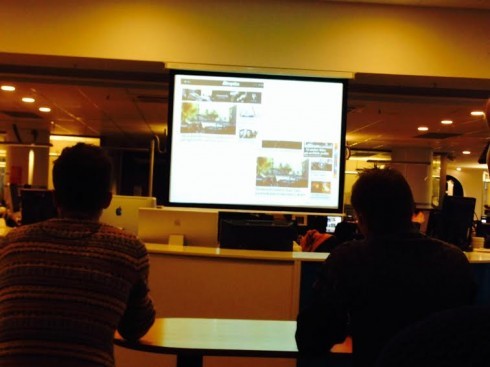TAKEAWAY: Newsroom morning meetings can make the difference if the editor leads the team in a constructive and inspiring session. At Norway’s Aftenposten, that is the case.


Critiques involve how stories played on all platforms, including print, of course

It is snowing outside this Monday morning in Oslo. Inside the newsroom of Aftenposten, one of Norway’s major dailies, it is a hot and invigorating workout.
Espen Egil Hansen, the newly appointed editor, leads his team in what is one of the most energizing, effective morning meetings I have seen recently in a daily newspaper.
Perhaps we can call this “the story first” morning meeting.
As someone who has sat through more newsroom morning meetings than he cares to enumerate, I know that, for the most, these are routine, boring and uninspired sessions, with a captive audience, little substance and more like a homeroom roll call to see that every section editor is alive and breathing over his cup of coffee or tea.
I have always wondered why the morning meeting is not utilized to do a quick review of “the best and the worst” of the newspaper’s performance the day before. I also wonder, in the day of Google, why more editors don’t spend time analyzing what gets read the most (and the least) and why.
That is why I felt so excited to attend this meeting at Aftenposten while working with the team this week in Oslo.
Espen begins with a graphic image of what stories did how on the various platforms: tablet, phone, PC. He then proceeds to review the ten stories that got the most readership. While he begins with how the digital platforms presented these stories, he also switches to the printed newspaper version of a particular story, discussing the writing, the tone of a headline and the use of images.
New editor, new meeting dynamics
“Here we did not change that photo of the Ukranian crisis during the day, but the competition did,” he points out.
“In my view, in today’s digital media world, we forget quality tomorrow, we emphasize quality now,” Espen tells his team. “In this morning meeting, I try to praise the team for what they did well, how they surprised the reader. That’s what’s important.”
Espen says that he begins preparing for his meeting at 6 a.m. each day, and the meeting is at 9:35.
“I know that I will have 15 minutes to accomplish a lot of things. The meeting has to move fast, but it must engage the team, gets them fired up, gets them to ask questions, to debate points,” he says.
I asked Espen how he developed his meeting style.
“For me, it all began when I was with my previous newspaper, VG+, and part of a digital team. There were 10 of us, and we would do exactly this, but limited to the digital side of the operation. It works, so why not transfer to the current situation, where I am the editor in chief and we cover all platforms. It makes no difference.”
“It’s a matter of getting everyone engaged in the discussion”
He emphasizes visuals during his discussion, not just in abstract terms, but showing examples of how a photo got used in various platforms.
“Was this the best possible photo we could have had to tell that story?,” he asks.
The team engages with Espen, providing commentary and background information.
“I also try to make sure that we start shifting mental directions in the newsroom, from a print orientation to more digital. It’s a process, we are getting there,” he said.
While the story comes first in the type of morning meeting Espen conducts each day, mobile is where the action begins, but without print getting neglected.
While Aftenposten is undergoing a total rethinking of content and strategy, I believe the first step towards making this a reality starts with the dynamics of Espen’s morning meeting.
A lecture about change
For those interested in listening to the lecture I gave last week to welcome journalism students back at Columbia University’s Graduate School of Journalism, here is a link:
Embracing and Promoting Change
http://new.livestream.com/cujs/designyourstory